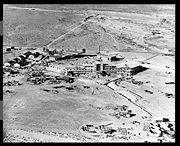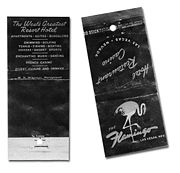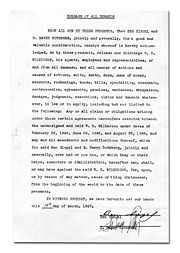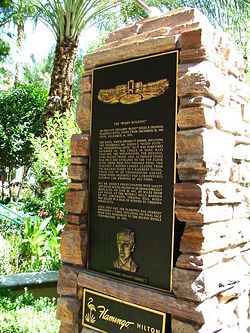Bugsy Siegel
| Benjamin Siegel | |
| Born | February 28, 1906 Williamsburg, Brooklyn, New York, USA |
|---|---|
| Died | June 20, 1947 (aged 41) Beverly Hills, California, USA |
| Cause of death | Murder |
| Resting place | Hollywood Forever Cemetery Hollywood, California, USA |
| Residence | Beverly Hills, California, USA |
| Nationality | American |
| Other names | Bugsy |
| Occupation | Organized crime |
| Religious beliefs | Jewish |
| Spouse(s) | Esta Krakower |
| Partner | Virginia Hill |
| Parents | Max Siegel, Jennie Goldstein |
Benjamin "Bugsy" Siegel (February 28, 1906 – June 20, 1947) was an American gangster behind large-scale development of Las Vegas.[1]
Contents |
Early life
Siegel was born in Williamsburg, Brooklyn, to a poor Jewish family from Letychiv,[2] Podolia Governorate of the Russian Empire, in modern Ukraine. As a boy, Siegel joined a gang on Lafayette Street on the Lower East Side of Manhattan and committed mainly thefts, until, with a youth named Moe Sedway, he devised his own protection racket: pushcart merchants were forced to pay a dollar or he would incinerate their merchandise .[3]
During adolescence, Siegel befriended Meyer Lansky, who was forming a small mob whose activities expanded to gambling and car theft. Siegel reputedly also worked as the mob's hit man, whom Lansky would hire to other crime families. In 1926, Lansky persuaded a woman Siegel had raped not to testify against him.[4]
In 1930, Lansky and Siegel built ties to Charles "Lucky" Luciano and Frank Costello, future bosses of the Genovese crime family. Siegel became a bootlegger and was associated with Albert "Mad Hatter" Anastasia. Siegel was involved in bootlegging in New York, New Jersey and Philadelphia. During the so-called Castellammarese War in 1930-1931, they finished the war by killing Sal Maranzano for Lucky Luciano; Luciano had eliminated Maranzano's rival and his own boss, Joe Masseria, ending the formal war, before having Maranzano murdered. Siegel reputedly had a hand in Maranzano's murder and later in the formation of Murder, Inc. In 1932, he was arrested for gambling and bootlegging but got off with a fine. Lansky and Siegel assisted in Luciano's brief alliance with Dutch Schultz and killed rival loan sharks Louis "Pretty" Amberg and Joseph Amberg in 1935.
California
In 1937, the East Coast mob sent Siegel to California to develop syndicate gambling rackets with Los Angeles mobster Jack Dragna. Once in L.A., Siegel recruited gang boss Mickey Cohen as his lieutenant. Siegel used syndicate money to set up a national wire service to help the East Coast mob quicken their returns.
On January 28, 1929, Siegel married Esta Krakower, his childhood sweetheart and sister of hit man Whitey Krakower. Siegel moved Esta and their two daughters, Millicent and Barbara, to the West Coast. Siegel had several mistresses, including actresses Ketti Gallian, Wendy Barrie, Marie "The Body" MacDonald, and Hollywood socialite Dorothy DiFrasso. With DiFrasso and actor friend George Raft, Siegel gained entry into Hollywood's inner circle, allegedly using his contacts to extort the movie studios. Siegel started living extravagantly; on tax returns he claimed to earn his living through legal gambling at Santa Anita Park near Los Angeles.
Siegel started an affair with Virginia Hill. Hill lived in a mansion in Beverly Hills that she rented from Metropolitan Opera baritone Lawrence Tibbett. Siegel became a frequent guest. There were rumors the couple had married in Mexico, where Hill helped Siegel establish drug dealing contacts. However, Siegel's relationship with Hill did not deter Siegel from womanizing.
On November 22, 1939, Siegel, Whitey Krakower, and two other gang members killed Harry "Big Greenie" Greenberg. Greenberg had become a police informant, and Louis "Lepke" Buchalter, boss of Murder, Inc., ordered his killing. Siegel was tried for the Greenberg murder. Whitey Krakower was killed before he could face trial. Siegel was acquitted but his reputation was in ruins. During the trial, newspapers revealed Siegel's past and referred to him as "Bugsy". He hated the nickname (said to be based on the slang "bugs", meaning "crazy", and used to describe his erratic behavior), and wouldn't be called it to his face.
Las Vegas



Siegel yearned to be legitimate. The legitimacy and respectability he craved was beyond his reach. But by spring 1946, it became stronger - in William R. Wilkerson's Flamingo.
Las Vegas gave Siegel his second opportunity to reinvent himself. Siegel had traveled to Southern Nevada in 1934 with Meyer Lansky's lieutenant Moe Sedway, on Lansky's orders to explore expanding operations. Lansky had turned the desert over to Siegel. But Siegel, wanting nothing to do with it, turned it over to Moe Sedway and fled for Hollywood.
Lansky pressured Siegel to represent them in Wilkerson's desert project. Someone had to watchdog their interests. Siegel, who knew Wilkerson and lived near him in Beverly Hills, was the obvious choice as a liaison. But Siegel was infuriated. He wanted no part in any operation that took him back to Nevada permanently. It meant forsaking Beverly Hills and playboy life and enduring the heat of Nevada. At Lansky's insistence, however, Siegel consented.
Throughout the spring of 1946, Siegel proved useful. He obtained black market building materials. The postwar shortages that had dogged construction were no longer a problem. At first Siegel seemed content to do things Wilkerson's way. His desire to learn about the project took precedence over his sportsman lifestyle. It subdued his aggression. Under Wilkerson, Siegel played the pupil, learning the mechanics of building an enterprise. The role did not come easily. Perhaps outdistanced and afraid of being upstaged by his mentor, Siegel began to feel intimidated and paranoid. He grew resentful of Wilkerson's talent and vision. As time went on, the gangster's admiration disintegrated into insane jealousy. Siegel reverted to his familiar role; the big-shot. He began making decisions without Wilkerson's authority. Informing work crews that Wilkerson had put him in charge, Siegel ordered changes which conflicted with the blueprints.
The problem came to a head when Siegel demanded more involvement in the project. To keep the project moving, Wilkerson agreed that Siegel would supervise the hotel while Wilkerson retained control of everything else.
Siegel's ambitions mushroomed into greed. Unhappy with arrangements negotiated by Harry Rothberg, the gangster began to view Wilkerson, who held the power, as a major obstacle. In May 1946, Siegel decided the agreement had to be altered to give him control of the Flamingo. Siegel offered to buy out Wilkerson's creative participation with corporate stock - an additional 5 percent ownership in the operation. On June 20, 1946, Siegel formed the Nevada Project Corporation of California, naming himself president. He was also the largest principal stockholder in the operation, which defined everyone else merely as shareholders. From this point the Flamingo became syndicate-run.
Siegel began a spending spreestaggering even today. He demanded the finest building that money could buy at a time of wartime shortages. Each bathroom of the 93-room hotel had its own sewer system. Cost: $1,150,000. More toilets were ordered than needed. Cost: $50,000. Because of the plumbing alterations, the boiler room, now too small, had to be enlarged. Cost: $113,000. Siegel ordered a larger kitchen. Cost: $29,000. Adding to the budgetary over-runs were problems with dishonest contractors and disgruntled unpaid builders. By day, trucks delivered black market goods. By night the same materials were pilfered and resold to Siegel a few days later. As costs soared, Siegel's checks began bouncing. By October 1946, the costs had soared above $4 million. In spring 1947, the Flamingo would clock in at over $6 million.
The first indication of trouble came in early November. The syndicate issued an ultimatum: provide accounting or forfeit funding. But the last thing Siegel wanted was produce a balance sheet. After the syndicate's refusal of help, Siegel waged a campaign of private fund raising. He sold nonexistent stock. Siegel was in a hurry to finish. He doubled his work force, believing the project could be completed in half the time. But it was costs, not building, that began rising faster. Siegel paid overtime and double-time. In some cases, bonuses tied to project deadlines were offered in hope of increasing productivity. By the end of November work was nearly finished.
Under pressure to have the hotel make some money, Siegel moved the opening from Wilkerson's original date of March 1, 1947 to the day after Christmas, 1946. Although the hotel was incomplete he was hoping to generate enough from the casino to complete the project and repay investors. Siegel announced the hotel would be ready the day after Christmas. Its opening would be held that same evening, December 26, 1946. Siegel generated confusion regarding the opening date. Acting on a whim, he decided a weekend would be more likely to entice celebrities away from home. Invitations were sent out for Saturday, December 28. Siegel changed his mind again. Invitees were notified by phone that the opening had been changed back to the 26th.
While locals jammed the opening, few celebrities materialized. A handful did motor in from Los Angeles despite appalling weather. Some of the celebrities present were June Haver, Vivian Blaine, George Raft, Sonny Tufts, Brian Donlevy and Charles Coburn. They were welcomed by construction noise and a lobby draped with decorators' drop cloths. The desert's first air conditioning collapsed at regularly. While gambling tables were operating, the luxury rooms that would have served as the lure for them to stay and gamble longer were not ready. After two weeks the Flamingo's gaming tables were $275,000 in the red and shut the entire operation in late January 1947.[5][6]
Death


On the night of June 20, 1947, as Siegel sat with his associate Allen Smiley in Virginia Hill's Beverly Hills home reading the Los Angeles Times, ex-mobster Eddie Cannizzaro entered the back yard and fired at him through the window with a .30-caliber military M1 carbine, hitting him many times including twice in the head. No one was charged with the murder, and the crime remains officially unsolved.[1]
Though descriptions held that Siegel was shot in the eye, an autopsy revealed the bullet entered the back of his skull, and exited through an eye; investigators found the eye across the room. The cause of death was cerebral hemorrhage. According to Florabel Muir, "Four of the nine shots fired that night destroyed a white marble statue of Bacchus on a grand piano, and then lodged in the far wall".
In the Bialystoker Synagogue on Manhattan's Lower East Side, Siegel is memorialized by a Yahrtzeit (remembrance) plaque that marks his death date so mourners can say Kaddish for the anniversary. Siegel's plaque is below that of his father, Max Siegel, who died two months prior to his son's murder.
Cultural references
- On 2pac's 1996 song 2 of Amerikaz Most Wanted, Snoop Dogg references Siegel with the lyrics "my dream is to own a fly casino like Bugsy Siegel, and do it all legal"
- In the 1969 novel The Godfather, and the 1972 film adaptation, the character of Moe Greene, played by Alex Rocco, was heavily based on Siegel. Although Greene's death is not described in the novel, in the film he is shot through the eye evoking Siegel's death. Additionally, the film's sequel adds a new character related to Greene, based upon Siegel's partner Meyer Lansky, named Hyman Roth.[8][9]
- In the television show The Sopranos, Brendan Filone is also executed with a bullet clean through the eye. The execution is referred to as a "Moe Greene Special", in reference to the way in which Moe Greene was killed, which in turn was based on Siegel.
- Sergio Leone's 1984 film Once Upon a Time in America and the obscure novel The Hoods upon which it was based, were loosely based upon the lives of Siegel and Lansky.[10]
- In the 1991 Bugsy, Warren Beatty portrays Siegel.
- In the 1981 NBC mini-series, The Gangster Chronicles, Joe Penny is cast as Siegel.
- Harvey Keitel portrayed Siegel in the 1974 film Virginia Hill: Mistress to the Mob.
- In the 1991 movie Mobsters Siegel is played by Richard Grieco.
- In the 1999 TV movie Lansky, the adult Siegel is played by Eric Roberts.
- In Tim Powers' novel Last Call, Siegel holds the supernatural office of the Fisher King of the American west. The construction of the Flamingo and Siegel's murder are both tied into a clandestine, magical conflict surrounding his kingship.
- In the Angel episode "The House Always Wins," Angel briefly mentions knowing Siegel.
References
- ↑ 1.0 1.1 "Siegel, Gangster, Is Slain On Coast. Co-chief of 'Bug and Meyer Mob' Here. Is Victim of Shots Fired Through Window.", New York Times (June 22, 1947, Sunday). Retrieved on 2007-10-31. "Benjamin Siegel, 42 years old, former New York gangster, was slain last midnight by a fusillade of bullets fired through the living room window of a Beverly Hills house where he was staying."
- ↑ Chapin, David A. and Weinstock, Ben, The Road from Letichev: The history and culture of a forgotten Jewish community in Eastern Europe, Volume 2. ISBN 0-595-00667-1 iUniverse, Lincoln, NE, 2000.
- ↑ Mark Gribben. "Bugsy Siegel". Crime Library.
- ↑ http://www.economicexpert.com/a/Bugsy:Siegel.htm
- ↑ Wilkerson III, W.R. (2000). The Man Who Invented Las Vegas. Ciro's Books. pp. 73-104. ISBN 0-9676643-0-6. http://cirosbooks.com/man_who_invented_las_vegas.html.
- ↑ Casino Connection Nevada | Vegas and the Mob
- ↑ On the plaques above see the name Max Siegel, Siegel's father, whose Hebrew name is "Mordechai Dov ben Reb (son of) Beirush HaLevi" (from the Hebraic tribe of the Levites) and the one for Siegel, whose Hebrew name is "Bairush HaLevi ben Reb Mordechai Dov HaLevi;" from this we see that Bugsy was named for his grandfather, Dov, meaning Bear (Bairush is the Yiddish for Dov), which was Americanized to Benjamin. All fathers are called Reb as an honorifc on memorial plaques; Reb means "teacher" as in Rabbi.
- ↑ "The Not-so-famous Alex Rocco", Boston Globe (November 13, 1989). Retrieved on 2008-07-20. "Until this year, Alex Rocco was best known as Moe Greene, the Bugsy Siegel character who was shot in the eyeglasses at the end of "The Godfather. ..."
- ↑ "Snap Judgment: Betting against the odds", Jerusalem Post (January 31, 2008). Retrieved on 2008-07-20. "Moe Greene is, of course, Lansky partner Benjamin "Bugsy" Siegel, who spearheaded the building of Las Vegas's first luxury casino-hotel, The Flamingo, ..."
- ↑ "Bending the Truth", Daily Mirror (January 30, 2004). Retrieved on 2008-07-20. "... saga around Jewish mob boss David "Noodles" Aaronson (Robert De Niro). The character was inspired by Meyer Lansky, a Russian immigrant who rose from the ..."
Further reading
- Hollywood's Celebrity Gangster. The Incredible Life and Times of Mickey Cohen by Brad Lewis. (Enigma Books: New York, 2007. ISBN 978-1-929631-65-0)
External links
- Bugsysiegel.net, various information including a copy of Siegel's death certificate
- FBI files on Siegel (2,421 pages, heavily censored) From the FBI Freedom of Information Act.
- Bugsy Siegel at Find-A-Grave
- Bugsy Siegel memorial in Las Vegas
- Benjamin "Bugsy" Siegel Profile and NY Times Article at J-Grit: The Internet Index of Tough Jews
- PBS American Experience